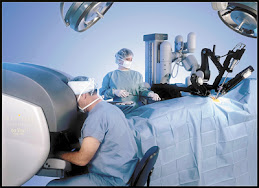http://www.springerlink.com/content/yt36507371120461/fulltext.html
Article in Journal of Robotic Surgery
May 30th, 2007
“Robotic assistance in urological microsurgery: initial report of a successful in-vivo robot-assisted vasovasostomy” appears in the July 2007 volume of The Journal of Robotic Surgery. The article is a case study where robotic surgery was used for urological microsurgery. More specifically, it is a case study of a single microscope-assisted vasovasostomy, which is the restoration of fertility after a pervious vasectomy. The surgery was conducted in the Onze-Lieve-Vrouw Hospital, in Alsat, Belgium.
The patient involved in the study is a 34-year old man who is interested in restoring fertility after having a vasectomy. The robotic device utilized for this surgery was the da Vinci robot. This robotic device was introduced to urological surgery seven years ago for more precise tissue dissection. However, now the use of this device is being expanded to include microsurgery in urology. Usually this device is used in corneal and plastic surgery. In this particular case, the main advantages of the da Vinci system were the 3D view, 30 times the magnification, detail suture placement but the main advantage is the elimination of tremor during surgery. The major disadvantage however is the loss of tactile sensation but this can be overcome by careful understanding of visual cues, such as suture stretching, to evaluate the surgical process. This particular surgery shows that robotic vasovasostomy is technically feasible and has a promising future in urological microsurgery.
This article is published in a very specialized journal, which focuses on only robotic surgery information and case studies. It doesn’t have much of an effect on the general public because of the scope of the publication but it does affect the surgeons, healthcare professionals, professors and students who subscribe to this publication. The information in this case study is very novel, hence, there are no contradictory studies on robotic urological microsurgery. However, since this is a singular case study there is a need for further research on the efficacy of robotic urological surgery. While this study contends that less experienced surgeons would have a better experience with robotics assisted surgery as opposed to microscope assisted surgery, this conclusion is based on the assumption that the surgeon has a general knowledge of robotic surgery, however since robotic surgery is a relatively novel concept in urological surgery , this knowledge isn’t very common. The main contribution of this case study is knowledge that the use of a common robotic surgical instrument can be used in a surgical field where robotic surgery is very rare. Since this article is a specific study, it only allows the reader a very isolated view of robotic surgery. However, this isolated view allows the reader to better understand the advantages and disadvantages of robotic surgery in the context of a single case. This understanding leads to a solid base of knowledge that the reader can subsequently expand on in future research.
Subscribe to:
Post Comments (Atom)

1 comment:
Dr. Anupam Goel is one of the Robotic Surgeon in Chandigarh as far as safe and effective laparoscopic operation is concerned. He has a vast experience in various operations such as gall bladder, hernia, appendicectomy, and bariatric operations. Dr. Goel is a known surgeon, who has a holistic treatment approach that gives the patients a sense of quality treatment delivery just like other nations would offe
Post a Comment